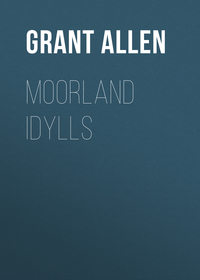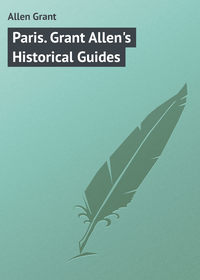 полная версия
полная версияFalling in Love; With Other Essays on More Exact Branches of Science
How, then, do originality, diversity, individuality, genius, begin to come in? In this way, as it seems to me, looking at the matter both à priori and by the light of actual experience.
Suppose a country inhabited in its interior by a savage race of hunters and fighters, and on its seaboard by an equally savage race of pirates and fishermen, like the Dyaks of Borneo. Each of these races, if left to itself, will develop in time its own peculiar and special type of savage cleverness. Each (in the scientific slang of the day) will adapt itself to its particular environment. The people of the interior will acquire and inherit a wonderful facility in spearing monkeys and knocking down parrots; while the people of the sea-coast will become skilful managers of canoes upon the water, and merciless plunderers of one another's villages, after the universal fashion of all pirates. These original differences of position and function will necessarily entail a thousand minor differences of intelligence and skill in a thousand different ways. For example, the sea-coast people, having of pure need to make themselves canoes and paddles, will probably learn to decorate their handicraft with ornamental patterns; and the æsthetic taste thus aroused will, no doubt, finally lead them to adorn the façades of their wooden huts with the grinning skulls of slaughtered enemies, prettily disposed at measured distances. A thoughtless world may laugh, indeed, at these naïve expressions of the nascent artistic and decorative faculties in the savage breast, but the æsthetic philosopher knows how to appreciate them at their true worth, and to see in them the earliest ingenuous precursors of our own Salisbury, Lichfield, and Westminster.
Now, so long as these two imaginary races of ours continue to remain distinct and separate, it is not likely that idiosyncrasies or varieties to any great extent will arise among them. But, as soon as you permit intermarriage to take place, the inherited and developed qualities of the one race will be liable to crop up in the next generation, diversely intermixed in every variety of degree with the inherited and developed qualities of the other. The children may take after either parent in any combination of qualities whatsoever. You have admitted an apparently capricious element of individuality: a power on the part of the half-breeds of differing from one another to an extent quite impossible in the two original homogeneous societies. In one word, you have made possible the future existence of diversity in character.
If, now, we turn from these perfectly simple savage communities to our own very complex and heterogeneous world, what do we find? An endless variety of soldiers, sailors, tinkers, tailors, butchers, bakers, candlestick makers, and jolly undertakers, most of whom fall into a certain rough number of classes, each with its own developed and inherited traits and peculiarities. Our world is made up, like the world of ancient Egypt and of modern India, of an immense variety of separate castes—not, indeed, rigidly demarcated and strictly limited as in those extremely hierarchical societies, but still very fairly hereditary in character, and given on the average to a tolerably close system of intermarriage within the caste.
For example, there is the agricultural labourer caste—the Hodge Chawbacon of urban humour, who in his military avatar also reappears as Tommy Atkins, a little transfigured, but at bottom identical—the alternative aspect of a single undivided central reality. Hodge for the most part lives and dies in his ancestral village: marries Mary, the daughter of Hodge Secundus of that parish, and begets assorted Hodges and Marys in vast quantities, all of the same pattern, to replenish the earth in the next generation. There you have a very well-marked hereditary caste, little given to intermixture with others, and from whose members, however recruited by fresh blood, the object of our quest, the Divine Genius, is very unlikely to find his point of origin. Then there is the town artisan caste, sprung originally, indeed, from the ranks of the Hodges, but naturally selected out of its most active, enterprising, and intelligent individuals, and often of many generations standing in various forms of handicraft. This is a far higher and more promising type of humanity, from the judicious intermixture of whose best elements we are apt to get our Stephensons, our Arkwrights, our Telfords, and our Edisons. In a rank of life just above the last, we find the fixed and immobile farmer caste, which only rarely blossoms out, under favourable circumstances on both sides, into a stray Cobbett or an almost miraculous miller Constable. The shopkeepers are a tribe of more varied interests and more diversified lives. An immense variety of brain elements are called into play by their diverse functions in diverse lines; and when we take them in conjunction with the upper mercantile grades, which are chiefly composed of their ablest and most successful members, we get considerable chances of those happy blendings of individual excellences in their casual marriages which go to make up talent, and, in their final outcome, genius. Last of all, in the professional and upper classes there is a freedom and play of faculty everywhere going on, which in the chances of intermarriage between lawyer-folk and doctor-folk, scientific people and artistic people, county families and bishops or law lords, and so forth ad infinitum, offers by far the best opportunities of any for the occasional development of that rare product of the highest humanity, the genuine genius.
But in every case it is, I believe, essentially intermixture of variously acquired hereditary characteristics that makes the best and truest geniuses. Left to itself, each separate line of caste ancestry would tend to produce a certain fixed Chinese or Japanese perfection of handicraft in a certain definite, restricted direction, but not probably anything worth calling real genius. For example, a family of artists, starting with some sort of manual dexterity in imitating natural forms and colours with paint and pencil, and strictly intermarrying always with other families possessing exactly the same inherited endowments, would probably go on getting more and more woodenly accurate in its drawing; more and more conventionally correct in its grouping; more and more technically perfect in its perspective and light-and-shade, and so forth, by pure dint of accumulated hereditary experience from generation to generation. It would pass from the Egyptian to the Chinese style of art by slow degrees and with infinite gradations. But suppose, instead of thus rigorously confining itself to its own caste, this family of handicraft artists were to intermarry freely with poetical, or seafaring, or candlestick-making stocks. What would be the consequence? Why, such an infiltration of other hereditary characteristics, otherwise acquired, as might make the young painters of future generations more wide minded, more diversified, more individualistic, more vivid and lifelike. Some divine spark of poetical imagination, some tenderness of sentiment, some play of fancy, unknown perhaps, to the hard, dry, matter-of-fact limners of the ancestral school, might thus be introduced into the original line of hereditary artists. In this way one can easily see how even intermarriage with non-artistic stocks might improve the breed of a family of painters. For while each caste, left to itself, is liable to harden down into a mere technical excellence after its own kind, a wooden facility for drawing faces, or casting up columns of figures, or hacking down enemies, or building steam-engines, a healthy cross with other castes is liable to bring in all kinds of new and valuable qualities, each of which, though acquired perhaps in a totally, different line of life, is apt to bear a new application in the new complex whereof it now forms a part.
In our very varied modern societies, every man and every woman, in the upper and middle ranks of life at least, has an individuality and an idiosyncrasy so compounded of endless varying stocks and races. Here is one whose father was an Irishman and his mother a Scotchwoman; here is another whose paternal line were country parsons, while his maternal ancestors were city merchants or distinguished soldiers. Take almost anybody's 'sixteen quarters'—his great-great grandfathers and great-great grandmothers, of whom he has sixteen all told—and what do you often find? A peer, a cobbler, a barrister, a common sailor, a Welsh doctor, a Dutch merchant, a Huguenot pastor, a cornet of horse, an Irish heiress, a farmer's daughter, a housemaid, an actress, a Devonshire beauty, a rich young lady of sugar-broking extraction, a Lady Carolina, a London lodging-house keeper. This is not by any means an exaggerated case; it would be easy, indeed, from one's own knowledge of family histories to supply a great many real examples far more startling than this partially imaginary one. With such a variety of racial and professional antecedents behind us, what infinite possibilities are opened before us of children with ability, folly, stupidity, genius?
Infinite numbers of intermixtures everywhere exist in civilised societies. Most of them are passable; many of them are execrable; a few of them are admirable; and here and there, one of them consists of that happy blending of individual characteristics which we all immediately recognise as genius—at least after somebody else has told us so.
The ultimate recipe for genius, then, would appear to be somewhat after this fashion. Take a number of good, strong, powerful stocks, mentally or physically, endowed with something more than the average amount of energy and application. Let them be as varied as possible in characteristics; and, so far as convenient, try to include among them a considerable small-change of races, dispositions, professions, and temperaments. Mix, by marriage, to the proper consistency; educate the offspring, especially by circumstances and environment, as broadly, freely, and diversely as you can; let them all intermarry again with other similarly produced, but personally unlike, idiosyncrasies; and watch the result to find your genius in the fourth or fifth generation. If the experiment has been properly performed, and all the conditions have been decently favourable, you will get among the resultant five hundred persons a considerable sprinkling of average fools, a fair proportion of modest mediocrities, a small number of able people, and (in case you are exceptionally lucky and have shuffled your cards very carefully) perhaps among them all a single genius. But most probably the genius will have died young of scarlet fever, or missed fire through some tiny defect of internal brain structure. Nature herself is trying this experiment unaided every day all around us, and, though she makes a great many misses, occasionally she makes a stray hit and then we get a Shakespeare or a Grimaldi.
'But you haven't proved all this: you have only suggested it.' Does one prove a thesis of deep-reaching importance in a ten-page essay? And if one proved it in a big book, with classified examples and detailed genealogies of all the geniuses, would anybody on earth except Mr. Francis Galton ever take the trouble to read it?
DESERT SANDS
If deserts have a fault (which their present biographer is far from admitting), that fault may doubtless be found in the fact that their scenery as a rule tends to be just a trifle monotonous. Though fine in themselves, they lack variety. To be sure, very few of the deserts of real life possess that absolute flatness, sandiness and sameness, which characterises the familiar desert of the poet and of the annual exhibitions—a desert all level yellow expanse, most bilious in its colouring, and relieved by but four allowable academy properties, a palm-tree, a camel, a sphinx, and a pyramid. For foreground, throw in a sheikh in appropriate drapery; for background, a sky-line and a bleaching skeleton; stir and mix, and your picture is finished. Most practical deserts one comes across in travelling, however, are a great deal less simple and theatrical than that; rock preponderates over sand in their composition, and inequalities of surface are often the rule rather than the exception. There is reason to believe, indeed, that the artistic conception of the common or Burlington House desert has been unduly influenced for evil by the accessibility and the poetic adjuncts of the Egyptian sand-waste, which, being situated in a great alluvial river valley is really flat, and, being the most familiar, has therefore distorted to its own shape the mental picture of all its kind elsewhere. But most deserts of actual nature are not all flat, nor all sandy; they present a considerable diversity and variety of surface, and their rocks are often unpleasantly obtrusive to the tender feet of the pedestrian traveller.
A desert, in fact, is only a place where the weather is always and uniformly fine. The sand is there merely as what the logicians call, in their cheerful way, 'a separable accident'; the essential of a desert, as such, is the absence of vegetation, due to drought. The barometer in those happy, too happy, regions, always stands at Set Fair. At least, it would, if barometers commonly grew in the desert, where, however, in the present condition of science, they are rarely found. It is this dryness of the air, and this alone, that makes a desert; all the rest, like the camels, the sphinx, the skeleton, and the pyramid, is only thrown in to complete the picture.
Now the first question that occurs to the inquiring mind—which is but a graceful periphrasis for the present writer—when it comes to examine in detail the peculiarities of deserts is just this: Why are there places on the earth's surface on which rain never falls? What makes it so uncommonly dry in Sahara when it's so unpleasantly wet and so unnecessarily foggy in this realm of England? And the obvious answer is, of course, that deserts exist only in those parts of the world where the run of mountain ranges, prevalent winds, and ocean currents conspire to render the average rainfall as small as possible. But, strangely enough, there is a large irregular belt of the great eastern continent where these peculiar conditions occur in an almost unbroken line for thousands of miles together, from the west coast of Africa to the borders of China: and it is in this belt that all the best known deserts of the world are actually situated. In one place it is the Atlas and the Kong mountains (now don't pretend, as David Copperfield's aunt would have said, you don't know the Kong mountains); at another place it is the Arabian coast range, Lebanon, and the Beluchi hills; at a third, it is the Himalayas and the Chinese heights that intercept and precipitate all the moisture from the clouds. But, from whatever variety of local causes it may arise, the fact still remains the same, that all the great deserts run in this long, almost unbroken series, beginning with the greater and the smaller Sahara, continuing in the Libyan and Egyptian desert, spreading on through the larger part of Arabia, reappearing to the north as the Syrian desert, and to the east as the desert of Rajputana (the Great Indian Desert of the Anglo-Indian mind), while further east again the long line terminates in the desert of Gobi on the Chinese frontier.
In other parts of the world, deserts are less frequent. The peculiar combination of circumstances which goes to produce them does not elsewhere occur over any vast area, on so large a scale. Still, there is one region in western America where the necessary conditions are found to perfection. The high snow-clad peaks of the Rocky Mountains on the one side check and condense all the moisture that comes from the Atlantic; the Sierra Nevada and the Wahsatch range on the other, running parallel with them to the west, check and condense all the moisture that comes from the Pacific coast. In between these two great lines lies the dry and almost rainless district known to the ambitious western mind as the Great American Desert, enclosing in its midst that slowly evaporating inland sea, the Great Salt Lake, a last relic of some extinct chain of mighty waters once comparable to Superior, Erie, and Ontario. In Mexico, again, where the twin ranges draw closer together, desert conditions once more supervene. But it is in central Australia that the causes which lead to the desert state are, perhaps on the whole, best exemplified. There, ranges of high mountains extend almost all round the coasts, and so completely intercept the rainfall which ought to fertilise the great central plain that the rivers are almost all short and local, and one thirsty waste spreads for miles and miles together over the whole unexplored interior of the continent.
But why are deserts rocky and sandy? Why aren't they covered, like the rest of the world, with earth, soil, mould, or dust? One can see plainly enough why there should be little or no vegetation where no rain falls, but one can't see quite so easily why there should be only sand and rock instead of arid clay-field.
Well, the answer is that without vegetation there is no such thing as soil on earth anywhere. The top layer of the land in all ordinary and well-behaved countries is composed entirely of vegetable mould, the decaying remains of innumerable generations of weeds and grasses. Earth to earth is the rule of nature. Soil, in fact, consists entirely of dead leaves. And where there are no leaves to die and decay, there can be no mould or soil to speak of. Darwin showed, indeed, in his last great book, that we owe the whole earthy covering of our hills and plains almost entirely to the perennial exertions of that friend of the farmers, the harmless, necessary earthworm. Year after year the silent worker is busy every night pulling down leaves through his tunnelled burrow into his underground nest, and there converting them by means of his castings into the black mould which produces, in the end, for lordly man, all his cultivable fields and pasture-lands and meadows. Where there are no leaves and no earth-worms, therefore, there can be no soil; and under those circumstances we get what we familiarly know as a desert.
The normal course of events where new land rises above the sea is something like this, as oceanic isles have sufficiently demonstrated. The rock when it first emerges from the water rises bare and rugged like a sea-cliff; no living thing, animal or vegetable, is harboured anywhere on its naked surface. In time, however, as rain falls upon its jutting peaks and barren pinnacles, disintegration sets in, or, to speak plainer English, the rock crumbles; and soon streams wash down tiny deposits of sand and mud thus produced into the valleys and hollows of the upheaved area. At the same time lichens begin to spring in yellow patches upon the bare face of the rock, and feathery ferns, whose spores have been wafted by the wind, or carried by the waves, or borne on the feet of unconscious birds, sprout here and there from the clefts and crannies. These, as they die and decay, in turn form a thin layer of vegetable mould, the first beginning of a local soil, in which the trusty earthworm (imported in the egg on driftwood or floating weeds) straightway sets to work to burrow, and which he rapidly increases by his constant labour. On the soil thus deposited, flowering plants and trees can soon root themselves, as fast as seeds, nuts or fruits are wafted to the island by various accidents from surrounding countries. The new land thrown up by the great eruption of Krakatoa has in this way already clothed itself from head to foot with a luxuriant sheet of ferns, mosses, and other vegetation.
First soil, then plant and animal life, are thus in the last resort wholly dependent for their existence on the amount of rainfall. But in deserts, where rain seldom or never falls (except by accident) the first term in this series is altogether wanting. There can be no rivers, brooks or streams to wash down beds of alluvial deposit from the mountains to the valleys. Denudation (the term, though rather awful, is not an improper one) must therefore take a different turn. Practically speaking, there is no water action; the work is all done by sun and wind. Under these circumstances, the rocks crumble away very slowly by mere exposure into small fragments, which the wind knocks off and blows about the surface, forming sand or dust of them in all convenient hollows. The frequent currents, produced by the heated air that lies upon the basking layer of sand, continually keep the surface agitated, and so blow about the sand and grind one piece against the other till it becomes ever finer and finer. Thus for the most part the hollows or valleys of deserts are filled by plains of bare sand, while their higher portions consist rather of barren, rocky mountains or table-land.
The effect upon whatever animal or vegetable life can manage here and there to survive under such circumstances is very peculiar. Deserts are the most exacting of all known environments, and they compel their inhabitants with profound imperiousness to knuckle under to their prejudices and preconceptions in ten thousand particulars.
To begin with, all the smaller denizens of the desert—whether butterflies, beetles, birds, or lizards—must be quite uniformly isabelline or sand-coloured. This universal determination of the desert-haunting creatures to fall in with the fashion and to harmonise with their surroundings adds considerably to the painfully monotonous effect of desert scenery. A green plant, a blue butterfly, a red and yellow bird, a black or bronze-coloured beetle or lizard would improve the artistic aspect of the desert not a little. But no; the animals will hear nothing of such gaudy hues; with Quaker uniformity they will clothe themselves in dove-colour; they will all wear a sandy pepper-and-salt with as great unanimity as the ladies of the Court (on receipt of orders) wear Court mourning for the late lamented King of the Tongataboo Islands.
In reality, this universal sombre tint of desert animals is a beautiful example of the imperious working of our modern Deus ex machinâ, natural selection. The more uniform in hue is the environment of any particular region, the more uniform in hue must be all its inhabitants. In the arctic snows, for example, we find this principle pushed to its furthest logical conclusion. There, everything is and must be white—hares, foxes, and ptarmigans alike; and the reason is obvious—there can be no exception. Any brown or black or reddish animal who ventured north would at once render himself unpleasantly conspicuous in the midst of the uniform arctic whiteness. If he were a brown hare, for example, the foxes and bears and birds of prey of the district would spot him at once on the white fields, and pounce down upon him forthwith on his first appearance. That hare would leave no similar descendants to continue the race of brown hares in arctic regions after him. Or, suppose, on the other hand, it were a brown fox who invaded the domain of eternal snow. All the hares and ptarmigans of his new district would behold him coming from afar and keep well out of his way, while he, poor creature, would never be able to spot them at all among the white snow-fields. He would starve for want of prey, at the very time when the white fox, his neighbour, was stealing unperceived with stealthy tread upon the hares and ptarmigans. In this way, from generation to generation of arctic animals, the blacker or browner have been constantly weeded out, and the greyer and whiter have been constantly encouraged, till now all arctic animals alike are as spotlessly snowy as the snow around them.
In the desert much the same causes operate, in a slightly different way, in favour of a general greyness or brownness as against pronounced shades of black, white, red, green, or yellow. Desert animals, like intense South Kensington, go in only for neutral tints. In proportion as each individual approaches in hue to the sand about it will it succeed in life in avoiding its enemies or in creeping upon its prey, according to circumstances. In proportion as it presents a strikingly vivid or distinct appearance among the surrounding sand will it make itself a sure mark for its watchful foes, if it happen to be an unprotected skulker, or will it be seen beforehand and avoided by its prey, if it happen to be a predatory hunting or insect-eating beast. Hence on the sandy desert all species alike are uniformly sand-coloured. Spotty lizards bask on spotty sands, keeping a sharp look-out for spotty butterflies and spotty beetles, only to be themselves spotted and devoured in turn by equally spotty birds, or snakes, or tortoises. All nature seems to have gone into half-mourning together, or, converted by a passing Puritan missionary, to have clad itself incontinently in grey and fawn-colour.









